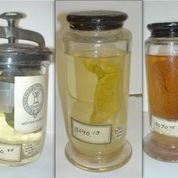Intestine From 1800s Cholera Victim Provides Clues About Deadly Pathogen; Preserved DNA Is A Window Into Historic Pandemics

A 200-year-old tissue specimen stored in a medical history museum allowed scientists to pull off a forensic feat by piecing together the entire genome of a bacterium that caused one of the deadliest cholera pandemics in history.
Hiding in plane sight
Thanks to the establishment of Philadelphia’s Mütter Museum in 1858, when the city was recovering from a severe cholera outbreak, researchers were able to acquire a sample of preserved intestine from a male victim who succumbed to the disease in 1849. The soft tissue contained tiny DNA fragments that allowed researchers to reconstruct the hereditary information of the exact species of the 19th century bacterium that caused the fatal outbreak. “The genomes of ancestral pathogens that have descendants today reside in these archival medical collections all over the world,” explained evolutionary geneticist at Canada’s McMaster University, Hendrik Poinar, in a press release. “We have access to hundreds of thousands of ancient specimens, which hold tremendous potential to determine the origins of past epidemics.”
Tracing and genetically reconstructing early strains of cholera have been unachievable up until now because the bacterium thrives in the intestine rather than bone or teeth, which are usually all that remain after people have been dead for a long time and not preserved. This absence of soft-tissue has hindered researchers from getting a hold of the DNA fingerprint belonging to older strains of the water-borne pathogen despite access to several cholera burials. But recently, it dawned on researchers from McMaster and University of Sydney that intestines that were kept during the time of the long-ago cholera outbreak and preserved at a medical history museum would likely contain traces of DNA of the killer bug.
Piecing Together A Monster
Modern techniques allowed the authors of The New England Journal of Medicine study to extract, purify, and enrich DNA belonging to this Cholera strain of yesteryear. As a result, they were able to deduce that it was probably more virulent than its current relatives partly owing to the ancient strain having more DNA sequences that armed it with greater toxicity.
The investigative team also confirmed that two types of this older, “classical,” form of cholera were probably the culprits behind five of seven killer outbreaks that occurred in the 1800s — which are suspected to have started in the waters of the Bay of Bengal. By the 1960s, a newer strain of cholera, the so-called El Tor, inexplicably took the reigns and recently reared its ugly head in Haiti after the massive 2010 earthquake struck.
Knowing Your Enemy
According to the World Health Organization, there are approximately three to five million cases of cholera per year with 100 to 120 thousand dying from the pathogen annually. This disease, which is caused by ingesting food or water that is contaminated with Vibrio cholerae bacteria, causes extreme diarrhea and can kill in a matter of hours if left untreated. It’s suspected that the common ancestor of the classical and El Tor cholera strain lurked in the waters of the Bay of Bengal for many thousands of years before human civilization enabled it to thrive as an infectious agent among people.
“Understanding the evolution of an infectious disease has tremendous potential for understanding its epidemiology, how it changes over time, and what events play a role in its jump into humans,” Poinar said. By knowing the factors that pushed this strain of cholera to become so adept at spreading, he added, will hopefully inform the development of better treatments that can control and prevent future widespread infections.
Source: Devault AM, Golding BG, Waglechner N, et al. Second-Pandemic Strain of Vibrio cholerae from the Philadelphia Cholera Outbreak of 1849. NEJM. 2014



























